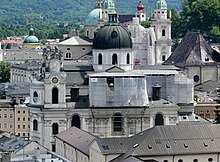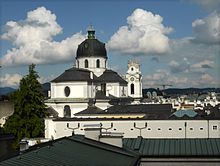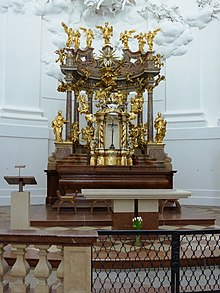Kollegienkirche (Salzburg)
The Kollegienkirche in Salzburg is the church of the University of Salzburg and dates from the baroque era . It is located on Universitätsplatz. The patronage is the Immaculate Conception of Mary , the patronage festival , in Austria a solemn festival and public holiday , is celebrated on December 8th . The church is a listed building and is part of the UNESCO World Heritage Historic Center of the City of Salzburg .
history
Prince Archbishop Paris von Lodron planned the construction of this own Roman Catholic University Church in Salzburg on the grounds of the former women's garden. It would take more than 70 years before the new church was completed by the architect Johann Bernhard Fischer von Erlach and consecrated in 1707 in honor of the Immaculate Virgin Mary. Until the collegiate church was built, the large auditorium of the university (next to the small house chapel Saecellum ) served not only as a theater, but together with the small sacellum as a sacred space for the university's church services. Also Guidobald of Thun and Max Gandolf of Kuenburg the promise of Kirchbaues could not fulfill. Prince Archbishop Johann Ernst von Thun only built the church against resistance. Above all, Josef von Kuenburg defended himself because, in his opinion, his Kuenburgscher Langenhof on Kirchgasse (today Sigmund-Haffner-Gasse) would be affected.
During the time of occupation by Napoleon and the French troops, the Kollegienkirche was demonstratively used as a military hay store. After the university was closed, it became a garrison church during the monarchy. In 1922, during the Salzburg Festival, Hugo von Hofmannsthal's Grand Theater of Salzburg was performed for the first time . The Kollegienkirche is still the venue of the Salzburg Festival today .
The Kollegienkirche has been a university church again since 1964. May 18, 2008 she received the rank of a parish church of the university parish (Hochschulgemeinde Salzburg), as a personal parish . University pastor has been Dr. Johann Wilhelm Klaushofer (as of August 2014). A general renovation of this old church was finally urgently required, as the load-bearing parts of the wooden roof structure were also heavily infested with fungi. First the chapel of St. Ivo was restored. In 2010 the apse was restored and the general renovation was largely completed by the end of 2013.
architecture
Today the church is the most important church building in the city of Salzburg next to the cathedral, a major work by the baroque architect Fischer von Erlach and a church building of international standing.
In favor of experiencing the entire building and its architecture, Fischer von Erlach lets the design of the detailed decorative elements recede - also through the execution of the church interior in a uniform white color without painting. The church building became the model for many late baroque churches in southern Germany.
The church has three parts: the magnificent facade facing north, the main building facing south and its sloping annexes. The towers have no domes , but rather dissolve towards the top in delicate balustrades crowned by allegorical figures. The figures represent on the left (in the west) the four evangelists (Matthew, Mark, Luke and John) and on the right (in the east) the four church fathers (Augustine, Ambrosius, Hieronymus and Gregory the Great). The figure of St. Mary Immaculate on one Crescent moon crowns the center of the building. In addition, angel figures can be seen to crown the main facade. All of these figures were created by Bernhard Michael Mandl .
Until 2012 there were stone statues in the 20 wall niches of the nave, which Johann Piger had made between 1905–1912. They have been removed and are now placed in the four oratorios . They are not visible from below.
The large and bright windows of the facade open the building to the outside and dissolve the heaviness of the facade. The delicate window decorations come from Diego Francesco Carlone and Paolo d'Allio , who, together with Fischer von Erlach, also designed the wall structure in the church in detail.
Altars
The inside of the church is vaulted with a towering barrel vault in the shape of a cross with colossal pilasters and a central drum dome, whereby the building is unified into a central building by the four high main chapels framing the main dome. These open chapels with their altars, which were incorporated into the church, shape the interior of the church alongside the main altar. The two central transept altars are each decorated with an altar sheet by Johann Michael Rottmayr . They show the then most important city saint, Borromeo when suffering from the plague and the university saint Benedict baptizing pagan princes. All altars are works by the court carpenter Simon Thaddäus Baldauf (1677–1753) from Au am Inn , and the barrel painter Peter Paul Perwanger .
High altar
Today's high altar was designed by Father Bernard Stuart and executed by Josef Anton Pfaffinger . The program of the high altar comes from the Old Testament and refers to a saying of Solomon ( Prov 9,1 EU ): “Wisdom built her house, carved her seven pillars.” In front of the pillars are allegorical figures of music, poetry, painting and architecture, as well as the four faculties. Love and hope float above it, inspired by faith. There are seven archangels standing at the height of the cornice. The altar dissolves towards the top in the stucco figures designed by Fischer von Erlach . He repeats and takes the main motives of the church. At the top of the choir, in front of the bright window of the apse, surrounded by sculpted clouds, numerous angels and a halo - as it were supernatural - Maria Immaculata appears on a crescent moon.
College altars
The collegiate altars are in four chapels and are consecrated to the saints of the four faculties.
- Clockwise starting from the main entrance on the left
- College of Medicine : St. Luke writing, in front an ox and two putti holding a herb book, on the right in the background the torture of the saint. Lateral figures of the hll. Aegydius and Magnus . → Collegium Medicine
- College of Theology : St. Thomas Aquinas writing, two great angels with him, the church fathers in clouds , clergymen at the bottom right. Lateral figures of the hll. Isidore and Burkard . → Collegium theology
- College of Jurisprudence (Jus) : St. Ivo von Kermartin to whom a boy hands a sheet of paper. Figures of the hll. Gregor and Anselm . Below is a copy of the miraculous image of Wessobrunn . → Collegium Jurisprudenz
- College of Philosophy : St. Catherine of Alexandria carried up by great angels. Lateral statues of Lanfrankus and Beda Venerabilis . → Collegium philosophy
organ
The organ was built by Matthäus Mauracher I in the years 1866–1868 . The instrument has 34 registers on three manuals and pedal , whereby the II. And III. Manual stand in a common swell box. Anton Bruckner must have appreciated this instrument very much. In the winter of 1869 he played " some fugues, in that strict form that corresponded to his reputation as a great contrapuntist who had ties to Beethoven, which he had already received in Nancy and Paris in the same year ". The following year he delighted “ several music lovers with an interesting production on the beautiful organ of the college church ”.
In 1982 the organ was restored by the Pirchner company . Among others, the zinc front pipes were again replaced by those made of tin it ( the tin of the [old] front pipes was "to secure the armor reserve of the Armed Forces" was delivered in 1917). In addition, the trumpet 8 ′ that was added later , housed in the lower part of the case on its own two drawers (C and C sharp sides), was shut down: the valves of the latter were attached to the main mechanism in a rather primitive way , which impaired the overall movement of the mechanism.
Disposition
|
|
|
|
||||||||||||||||||||||||||||||||||||||||||||||||||||||||||||||||||||||||||||||||||||||||||||||||||||||||||||||||||||||||||||||||||||||||||||||||||||||||||||||||||||
Remarks
- ↑ Added after 1885.
- ↑ Added after 1885, resounding, in own shop. Shut down in 1982.
- ↑ With leather-covered wooden throats .
literature
- Alice Schulte: The Collegiate Church in Salzburg. An impressionistic study. In: Mitteilungen der Gesellschaft für Salzburger Landeskunde 57, Salzburg 1917, pp. 1–12.
- Felicitas Hagen-Dempf: The Collegiate Church in Salzburg. Vienna 1949.
- Pius Bieri: The university or college church in Salzburg , Rüti ZH (CH) 2017.
In compendia:
- Bernd Euler, Ronald Gobiet, Horst Huber: Dehio Salzburg - City and Country. Wien Verlag Anton Schroll & Co 1986, ISBN 3-7031-0599-2 , p. OA
- Lieselotte von Eltz-Hoffmann: The churches of Salzburg. Verlag Anton Pustet, Salzburg 1993, ISBN 3-7025-0308-0 .
- → See also Johann Bernhard Fischer von Erlach: Literature
Details:
- Hans Tietze: Two drawings by Fischer von Erlach for the Collegiate Church in Salzburg. In: Yearbook of the Art History Institute of the kk Central Commission for Monument Preservation 5, Vienna 1911, pp. 105–110.
- Hermann Fillitz : The Collegiate Church in Salzburg. Your relationship to the Roman architecture of the 17th century. In: Wiener Jahrbuch für Kunstgeschichte 25, Vienna 1972, pp. 259–267.
- Stefan Hiller, Adolf Hahnl: The Salzburg University Church . The large dedication engraving by J. Ulrich Kraus after Mrs. Aemilian Rösch OSB. In: Salzburger Museumsblätter 34/1, Salzburg 1973, pp. 4–5.
- Martin Stankowski: The Kollegienkirche and its requirements. In: Wiener Jahrbuch für Kunstgeschichte 29, Vienna / Cologne / Graz 1976, pp. 175–185.
- Franz Wagner: Immaculata and Transfiguration - Comments on the high altar of the Salzburg Collegiate Church. In: Alte und Moderne Kunst 24, Vienna 1979, pp. 14–18.
- Hans Sedlmayr: The collegiate church and the church of the Sorbonne. In: Communications of the Society for Salzburg Regional Studies 120/121, Salzburg 1980–1981, pp. 371–398.
- Franz Fuhrmann: The floor plan of the collegiate church and its proportions. In: Imagination and Imago. Festschrift Kurt Rossacher, ed. v. Franz Wagner, Salzburg 1983, pp. 57-68.
- Thomas Zaunschirm: Views of the structure of the Salzburg University Church . In: From Austrian Art. Dedicated to Franz Fuhrmann, ed. v. Institute for Art History of the University of Salzburg, included. v. Monika Oberhammer / Thomas Zaunschirm, Klagenfurt o. J. [1983], pp. 105–112.
- Franz Fuhrmann: The paving of the college church in Salzburg. In: Old and modern art [Festgabe für Erich Hubala] 30/200, Vienna 1985, pp. 13-16.
- Franz Fuhrmann: The development of the floor plan of the Salzburg University Church Fischer von Erlach with regard to the proportions. In: Orient and Occident in the mirror of art. Festschrift for Heinrich Gerhard Franz's 70th birthday, ed. v. Günter Brucher / Wolfgang T. Müller / Horst Schweigert / Brigitte Wagner, Graz 1986, pp. 93–114.
- Gerhard Horn, Ilse Lackerbauer, Hans Simmerstätter, Alfred Denk (Red.): University Church (Kollegienkirche). Roof and facade renovation 1983–1985. Salzburg 1986 (= construction documentation of Department 6 , Vol. 18).
- Andreas Kreul: The Collegiate Church of Johann Bernhard Fischer von Erlachs in Salzburg. On the relationship between the parish and the sanctuary. Considerations following Leibniz. In: Religion and Religiosity in the Age of Baroque (= Wolfenbütteler Arbeit zur Barockforschung Vol. 25), ed. v. Dieter Breuer / Barbara Becker-Cantarino / Heinz Schilling / Walter Sparn, Wiesbaden 1995, pp. 305-324.
- Adolf Hahnl: The consecration festival for the University Church of Salzburg. In: Studies and communications on the history of the Benedictine Order 108, St. Ottilien 1997, pp. 375–404.
- Karin Uetz: Observations on the building history of the Salzburg Collegiate Church. In: Barockberichte 18/19, Salzburg 1998, pp. 92–116.
- Ulrich Fürst / Peter Prange: The 'Prospectus Interior' of the Salzburg Collegiate Church on the dedication engraving from 1707 - a singular spatial representation and its foundations in baroque printmaking. In: Barockberichte 24/25, Salzburg 1999, pp. 425–445.
- Ulrich Fürst: The living and visible histori. Programmatic themes in the sacred architecture of the Baroque (Fischer von Erlach, Hildebrandt, Santini). Regensburg 2002.
- Peter Husty, Tanja Husty: The crack "to the new tabernacul made by Stein, and Khupfer in the university khirchen" - to a draft and the program of the high altar of the collegiate church in Salzburg. In: Barockberichte 36/37, Salzburg 2004, pp. 501–504.
- Constanze Schuler: The altar as a stage. The Kollegienkirche as the venue for the Salzburg Festival. Francke Verlag, Tübingen 2007.
Web links
- Catholic University Community of Salzburg (staff parish of the church)
- Kollegienkirche Salzburg (to the church)
- Kollegienkirche . In: Salzburger Nachrichten : Salzburgwiki .
- Kollegienkirche (university church) , salzburg.info
proof
- ↑ Personnel of the world and religious clergy of the Archdiocese of Salzburg for 1957 ( Schematismus 1957), ed. from the Archbishop's Office of Salzburg 1957, p. 154.
- ↑ Kollegienkirche ( Memento of the original from May 5, 2013 in the Internet Archive ) Info: The archive link was inserted automatically and has not yet been checked. Please check the original and archive link according to the instructions and then remove this notice. , Salzburg Festival → Venues
-
↑ Parish area includes the pastoral care of all Roman Catholic. Lecturers, students, administrative staff at universities, colleges of education and technical colleges in the area of the Archdiocese of Salzburg.
Parish Salzburg University Parish, Parish Directory Archdiocese Salzburg, kirchen.net - ↑ A world-class jewel - ceremony and benefit concert in the Salzburg Collegiate Church. Completion of the apse as an important stage in the interior restoration. Federal Monuments Office, Work in Progress , accessed February 2, 2013
- ↑ Information on the organ
- ↑ Salzburger Volksblatt of April 7, 1869 and September 9, 1870. Quoted from: Gerhard Walterskirchen: Building history of the organ of the university church. In: The organ of the University Church Salzburg. Consecration of the renovated Mauracher organ 10 July 1982, p. 18f.
- ^ Gerhard Walterskirchen: building history of the organ of the university church. In: The organ of the University Church Salzburg. Consecration of the renovated Mauracher organ 10 July 1982, p. 19.
- ^ Johann Pirchner: The restoration of the Mauracher organ in the University Church of Salzburg. In: The organ of the University Church Salzburg. Consecration of the renovated Mauracher organ on July 10, 1982, p. 29.
Coordinates: 47 ° 47 '57 " N , 13 ° 2' 35" E









